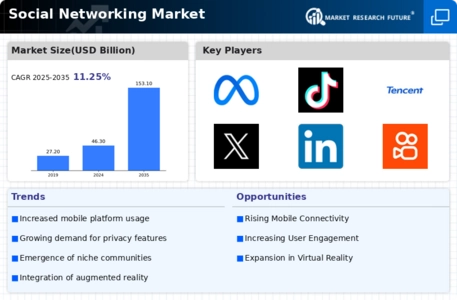The Social Networking Market is currently characterized by a dynamic competitive landscape, driven by rapid technological advancements and shifting user preferences. Major players such as Meta Platforms (US), TikTok (CN), and LinkedIn (US) are at the forefront, each adopting distinct strategies to enhance their market positioning. Meta Platforms (US) continues to innovate with its focus on augmented reality and virtual reality, aiming to create immersive social experiences. Meanwhile, TikTok (CN) leverages its algorithm-driven content delivery to maintain user engagement, while LinkedIn (US) emphasizes professional networking and skill development, thereby catering to a niche yet expanding audience. Collectively, these strategies contribute to a competitive environment that is increasingly defined by user-centric innovations and diversified service offerings.
In terms of business tactics, companies are increasingly localizing their operations to better serve regional markets, which appears to be a response to the growing demand for tailored content. The market structure is moderately fragmented, with a mix of established giants and emerging platforms vying for user attention. This fragmentation allows for a variety of business models, from ad-supported free services to subscription-based premium offerings, which collectively influence user engagement and revenue generation.
In August 2025, TikTok (CN) announced a partnership with several educational institutions to launch a new initiative aimed at promoting digital literacy among young users. This strategic move not only enhances TikTok's brand image as a socially responsible platform but also positions it as a leader in the educational content space, potentially attracting a broader user base. The initiative underscores the platform's commitment to fostering a safe and informed community, which may lead to increased user loyalty and engagement.
In September 2025, Meta Platforms (US) unveiled a new suite of tools designed for creators, enabling them to monetize their content more effectively. This development is strategically significant as it aligns with the growing trend of content creator economies, allowing Meta to retain top talent on its platform. By enhancing monetization options, Meta not only strengthens its competitive edge but also fosters a vibrant ecosystem that could drive user retention and attract new creators.
In October 2025, LinkedIn (US) launched a new feature that integrates AI-driven job matching capabilities, enhancing the user experience for job seekers and employers alike. This innovation is crucial as it streamlines the recruitment process, making it more efficient and user-friendly. By leveraging AI, LinkedIn positions itself as a forward-thinking platform that prioritizes user needs, potentially increasing its market share in the professional networking space.
As of October 2025, the Social Networking Market is witnessing a pronounced shift towards digitalization, with trends such as AI integration and sustainability becoming increasingly prominent. Strategic alliances among key players are shaping the competitive landscape, fostering innovation and collaboration. Looking ahead, it is likely that competitive differentiation will evolve, moving away from traditional price-based competition towards a focus on technological innovation, user experience, and supply chain reliability. This shift suggests that companies will need to invest in cutting-edge technologies and sustainable practices to maintain their competitive advantage.


















Leave a Comment